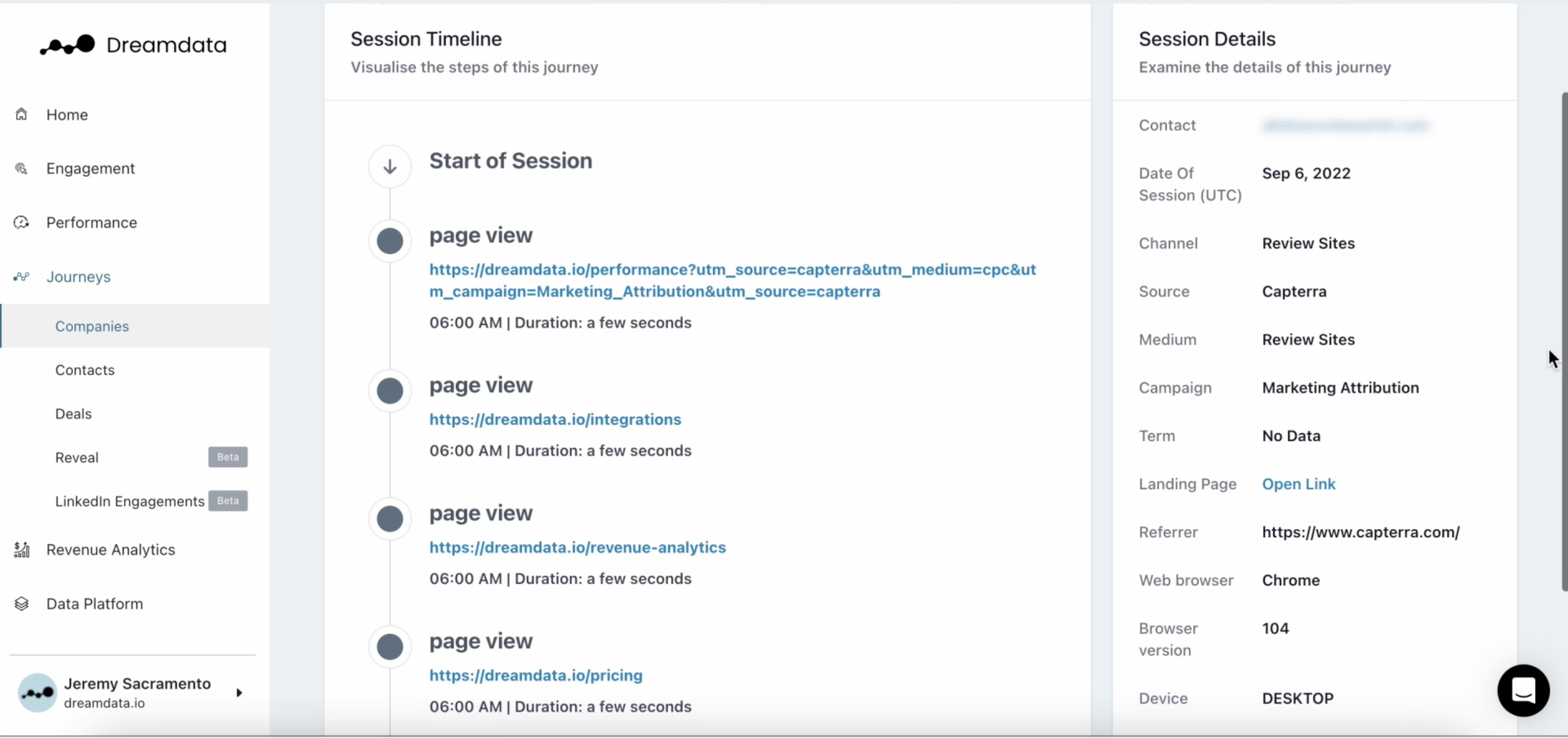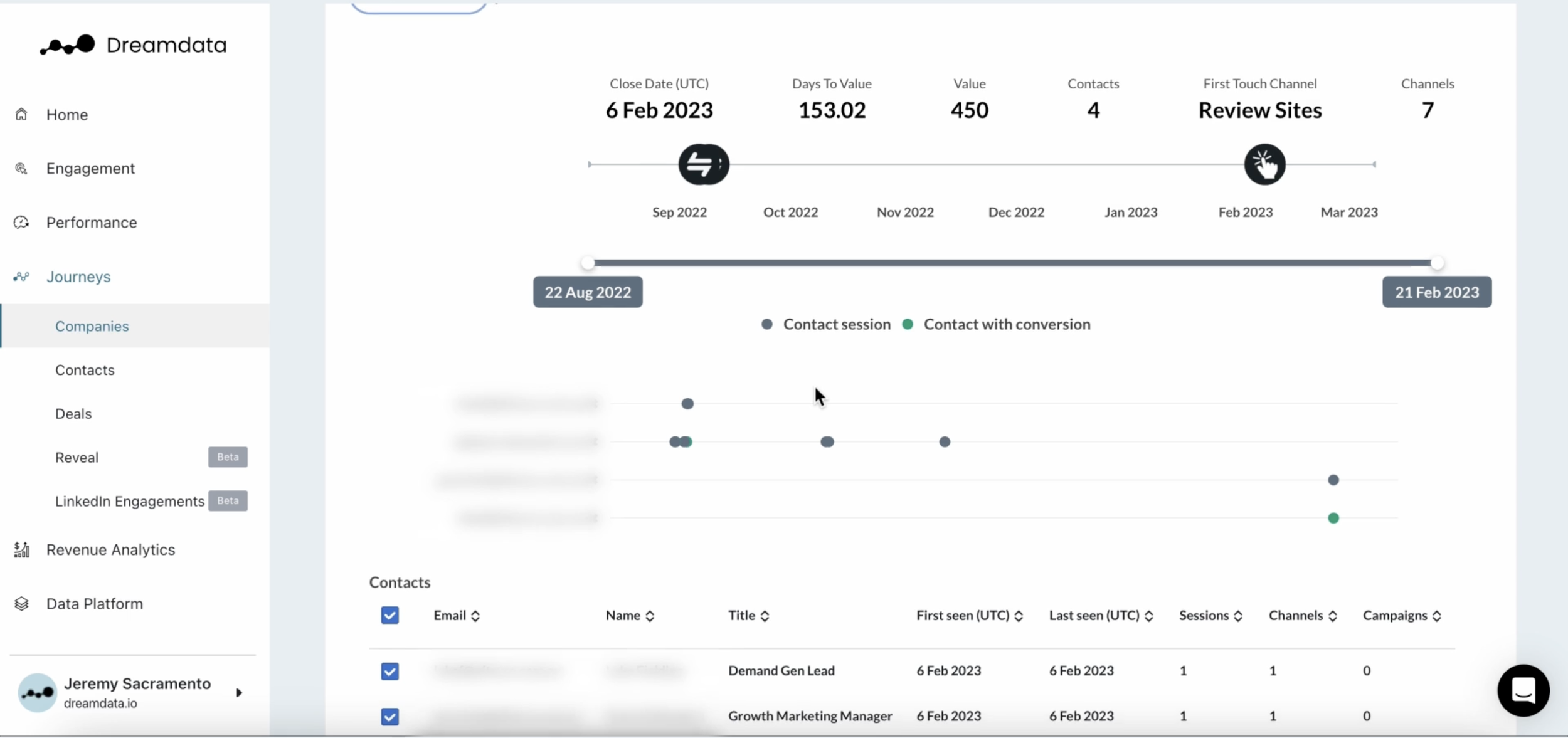Customer journey analysis: a qualitative approach to repeating success
With customer journey analysis B2B marketers can examine the order of touches that lead to successful customer journeys. From this, we are then able to replicate success in our account-based campaigns.
Intro to customer journey analysis
For the most part, marketing analytics involves measuring performance from the perspective of the activities you’re running, such as how many clicks Campaign A has generated, or how many leads Channel X has produced.
However, there are times when this method doesn’t suffice. In particular, when setting up a highly targeted ABM campaign, where you want to replicate success from similar accounts.
For this, we need to understand how the different marketing efforts are stitched together in helping these accounts down the path to purchase.
Which means, we need a more qualitative approach that evaluates performance from the perspective of the customer journey. I.e. how did Campaign A impact Journey X?
Enter customer journey analysis.
In this article, we’re examining the power of customer journey analysis and how this method can help B2B marketers gain a deeper understanding of what moves customers to purchase and how to repeat this success.
Let’s dive in!
Contents:
What is customer journey analysis?
How does customer journey analysis compare with traditional marketing analytics methods?
Why use customer journey analysis
An example case of customer journey analysis - with real data!
[take me straight here →]Getting started with customer journey analysis: a question of data
What is Customer Journey Analysis?
In a nutshell, customer journey analysis focuses on understanding the series of interactions a specific customer has with a business over time across multiple touchpoints and channels.
Instead of assessing singular actions or interactions in isolation, like traditional marketing analytics methods (more on this below), the customer journey analysis methodology evaluates interactions in the context of the customer journey.
This not only allows us to identify the key engagement points in a particular journey but also enables us to scrutinise how these various touchpoints interrelate and influence the overall journey. From this, we are then able to put together an ABM strategy for lookalike accounts.
How customer journey analysis compares with traditional marketing analytics methods
‘Traditional’ marketing analytics methods focus on quantifying singular data points or isolated actions, for instance, counting the number of conversions a particular campaign or segment has clocked over a given period.
That is, it puts the activity - a paid ad campaign, blog post, etc. - as the focal point, from which the B2B marketer can answer the question, ‘How many conversions has Campaign X generated?’ or ‘How much traffic did Blog Y attract?’.
The strength of this method, as we all know, lies in its ability to provide the marketer with insights into the performance of every channel, campaign, and piece of content. From which we can then evaluate what’s working and what isn’t, and therefore where to invest or divest.
However, this traditional approach lacks context and depth of the specific journeys they form part of. What does a successful customer journey actually look like? Is there any pattern in the channels and campaigns that the very best accounts go through on their path to purchase?
Customer journey analysis answers just these questions.
You might be interested in this post about Revenue Marketing —>
Why use customer journey analysis?
As we’ve already mentioned, customer journey analysis is the ideal choice when seeking to replicate success in high-value ABM campaigns.
Success in ABM campaigns rests in delivering highly targeted, personalised and timely customer experience.
And what better starting point than a success case from a lookalike account? The key personas, the key campaigns and channels, the key content. Less hit and miss, less waste.
Check out how Kathrine Rasmusen, CMO at Pixelz, finds value from looking at historical journeys of their biggest customers.
In the main, customer journey analysis enables us to:
1) Deeply understand our success case which we can then model in highly targeted ABM strategies, including:
Identify who the ideal personas are in the buying process.
Knowing what activities made the success case click - ad campaign, blog post, newsletter subscriptions.
Identifying how long you can expect the journey (and each stage of it) to take - and align expectations accordingly, and,
Predicting and preempting challenges that were encountered in the success journey.
2) Analyse the effectiveness of activities on journeys in ‘real-time’ - if you’re gathering and plotting the journey data dynamically - which you can then use to modify the journeys accordingly. E.g. say they’ve just read a blog post your next message could reflect that.
Personalise Experiences - you can craft highly personalised experiences that resonate with each account.
Example of customer journey analysis
We’ve selected a success case journey based on the objectives of our ABM strategy, which is to target a list of high-value B2B fin-tech SaaS companies of approx. 200 employees.
First, we want to take note of the time-to-value metric across the whole journey and for each stage of the pipeline. This will not only help us set expectations for how long the journeys will likely take, but also to benchmark whether accounts are taking too long to react, or need further prompting.
The next thing we want to look at is the customer journey map itself. What was the first touch and who made it?
Well here it was a Review site, in this case, Capterra, under the ‘Marketing Attribution’ category, and it was the Head of Marketing who made it. In the same session, this individual went onto our integrations page, revenue analytics feature page, and finally, our pricing page.
Three days then pass before the next touch takes place. The Demand Gen Lead directly lands on one of our blog posts - 6 causes of dirty CRM data - which we can assume came from an organic/ social-selling LinkedIn post. Two hours later the Head of Marketing starts the Free sign-up process.
Yet, bar a blog post read (from our Newsletter) and an organic search for ‘Dreamdata’ by the Head of Marketing, three months elapse before there’s any product activity, when the Growth Marketing Manager once again signs-up for our Free tier.
Applying the findings
This analysis then puts us in a great position to action our ABM strategy on our lookalike target list.
There are four things we can now apply to our campaigns.
1) We’re going to focus primarily on the Head of Marketing and Growth Gen personas.
2) Review sites matter to this audience, so:
- We must ensure we have a presence on relevant review sites - whether that’s organically (by ranking in the relevant categories) or through paid ads on the platforms.
- Run targeted campaigns/ outreach on LinkedIn to showcase our review rating and reviews from these sites to our personas.
3) Ensure these accounts are in our social media/ social selling network and run relevant content on critical pain points for this segment - focusing in particular on data quality.
4) Get these personas to subscribe to our Newsletter - whether through personal outreach or targeted ad campaigns.
Getting started with customer journey analysis: a question of data
There are two fundamental components to running reliable customer journey analyses:
1: Making sure you're collecting all the relevant data from across the customer journey.
The B2B customer journey is long and complex. It takes place across multiple channels, over multiple months. This data is then spread across and siloed in the tools you use to run your efforts - ad platforms, automation tools and CRM.
This data needs to be joined and cleaned (to avoid things like duplication and null values), before customer journeys can be put together.
There are, of course, off-the-shelf specialised B2B tools readily available to automate this process for you, whether that’s a CDP, attribution tool, or other data transformation solution.
2: A Detailed Map of Touchpoints
Once you’ve collected all the data you need, you can visualise the customer journey map. This map should outline the path customers take from their initial interaction with your brand through to a final transaction or endpoint.
Again here there are mapping tools readily available. Tools like Dreamdata, which collect, transform and visualise the data under the same roof.
It is only with these in place that you can start analysing the customer journey data and running your competition-beating ABM campaigns.
Conclusion
Customer journey analytics is a powerful tool for enhancing B2B marketing efficiency. Unlike traditional marketing analytics methods that focus on isolated actions or interactions, customer journey analytics provides an overview of the complete customer journey.
It enables marketers to understand the interconnected nature of customer interactions and how they influence the overall experience.
By analysing every touchpoint and interaction throughout the customer journey, companies can gain valuable insights into the success factors and pain points specific to each account.
When integrated with ABM campaigns, customer journey analytics further enhances personalisation, improves timing, enhances engagement, predicts and preempts challenges, and allows for real-time assessment of campaign effectiveness.
Get started with customer journey analysis today.




